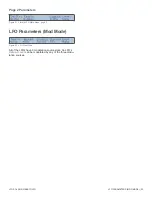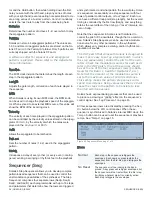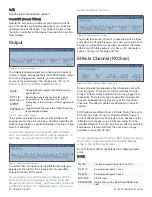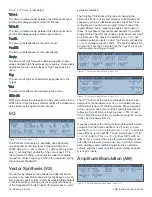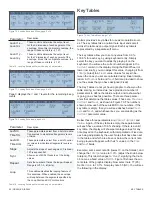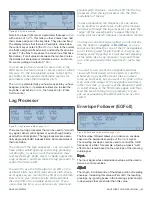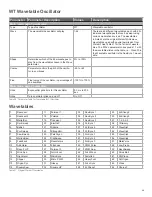
AMPLITUDE MODULATION (AM)
40 | GRAPHIC DISPLAY
synthesis modules.
The Prophet VS introduced the idea of changing the
harmonic structure of the ‘raw material’ to be filtered and
shaped by using a 2-dimensional mixer. We called it Vec-
tor Synthesis. You can also program this with one of the
regular Mixers, but to make things easier, I put in two of
these ‘Vector Mixers’ (essential quad panners) to simplify
programming. The VS1 mixer has 4 signal inputs, each with
an initial Level. The X-axis (controlled by
SourceX
) will
crossfade between inputs 1 and 2; the Y-axis (controlled by
SourceY
) between inputs 3 and 4. The ‘factory default’ for
Source X & Y are the 2 outputs from the
Joystick
, but you
could program anything you want.
Figure 71. Vector Synthesis Menu, page 1 of 2
Figure 72. Vector Synthesis Menu, page 2 of 2
The X/Y “motion” of the vector synthesis module can be
assigned to the hardware
Joystick
, or modulated by any
of Solaris’ extensive modulation sources. When assigned
to the
Joystick
, each corner of the control represents the
full level of one of the four input sources.
X-Offset
and
Y-
Offset
shift the value of the x/y control, moving the “center”
of the
Joystick
away from 0,0.
If you take a look at the factory setting (default patch when
you switch on the Solaris without any CF card), you can
see that
Input1
-
Input4
are set to
Oscs 1
-
Osc 4
, all at full
Level. Moving to the next VS 1 page, you will see
JoyX
for
SourceX
, and
JoyY
for
SourceY
, both at 100%, with no
offsets. If you now set the tuning for each oscillator at obvi-
ous different intervals, you can use the
Joystick
to isolate
each oscillator, and crossfade between the 4 oscillator
outputs, with the center
Joystick
position being an equal
mix of all 4 inputs.
Amplitude Modulation (AM)
Figure 73. Amplitude Modulation Menu, page 1 of 1
Delay
, or
XDelay
(cross delay).
Time L
The time (in milliseconds) between the initial input sound
and the first delayed output of the left channel.
Time R
The time (in milliseconds) between the initial input sound
and the first delayed output of the right channel.
Feed L
The amount of feedback for the left channel
Feed R
The amount of feedback for the right channel
Damp
The amount of high frequency damping applied. Higher
values dampen high frequencies more quickly, more closely
approximating the natural decay of high frequencies in a
room.
Dry
The amount of original, unaffected signal passed to the
output.
Wet
The amount of effect sound passed to the output.
MIDI Clk
MIDI Sync allows the delay effect to be synchronized to the
MIDI Clock. Clock division selectors replace the millisecond
delay times for the right and left channel.
EQ
Figure 70. EQ Menu, page 1 of 1
The EQ effect module is a 3-band EQ, each band with
an assignable center frequency between 0.00Hz and
20000.0Hz. A
Gain
cut or boost of 12 dB per band is avail-
able.
Q
controls the bandwidth of the cut or boost; 0.7 is
the minimum
Q
setting, and allows the widest bandwidth
around the center frequency. 20.00 is the maximum, giving
the narrowest bandwidth.
Vector Synthesis (VS)
The Vector Synthesis section allows four different sound
sources to be mixed/morphed dynamically based on a 2 di-
mensional x/y vector graph. Vector Synthesis allows Solaris
to achieve swirling, moving dynamic sounds reminiscent
of the Sequential Circuits Prophet VS. Solaris has 2 vector
Summary of Contents for Solaris
Page 1: ...User Guide Version 1 ...








